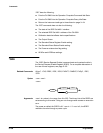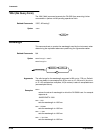
Status and Events
Programming
3 --- 36
Table 3 -8: SESR Bit Functions
Bit
Function
7 (MSB) PON (Power On). Shows that the OA 5000 was powered on.
6 URQ (User Request). Shows that the Remote button was
pressed.
5 CME (Command Error). Shows that an error occurred while
the OA 5000 was parsing a command or query. Command
error messages are listed in Table 3-11 on page 3---41.
4 EXE (Execution Error). Shows that an error occurred while
the OA 5000 was executing a command or query. Execution
error messages are listed in Table 3-12 on page 3---42.
3 DDE (Device Error). Shows that a device error occurred. De-
vice error messages are listed in Table 3-13 on page 3---43.
2 QYE (Query Error). Shows that either an attempt w as made
to read the Output Queue when no data was present or
pending, or that data in the Output Queue was lost.
1 RQC (Request Control). Not used.
0(LSB) OPC (Operation Complete). Shows that the operation is com-
plete. This bit is set by the *OPC command.
The Status Byte Register (SBR) — shown in Figure 3-7, records wheth-
er output is available in the Output Queue, whether the OA 5000 requests
service, and whether the SESR has recorded any events.
Use a Serial Poll or the *STB? query to read the contents of the SBR. Refer
to Table 3-9. The bits in the SBR are set and cleared depending on the
contents of the SESR, the Event Status Enable Register (ESER), and the
Output Queue. (When you use a Serial Poll to obtain the SBR, bit 6 is the
RQS bit. When you use the *STB? query to obtain the SBR, bit 6 is the MSS
bit.)
—
RQS
ESBMAV————
MSS
7
6
543210
6
Figure 3-7: The Status Byte Register (SBR)


















